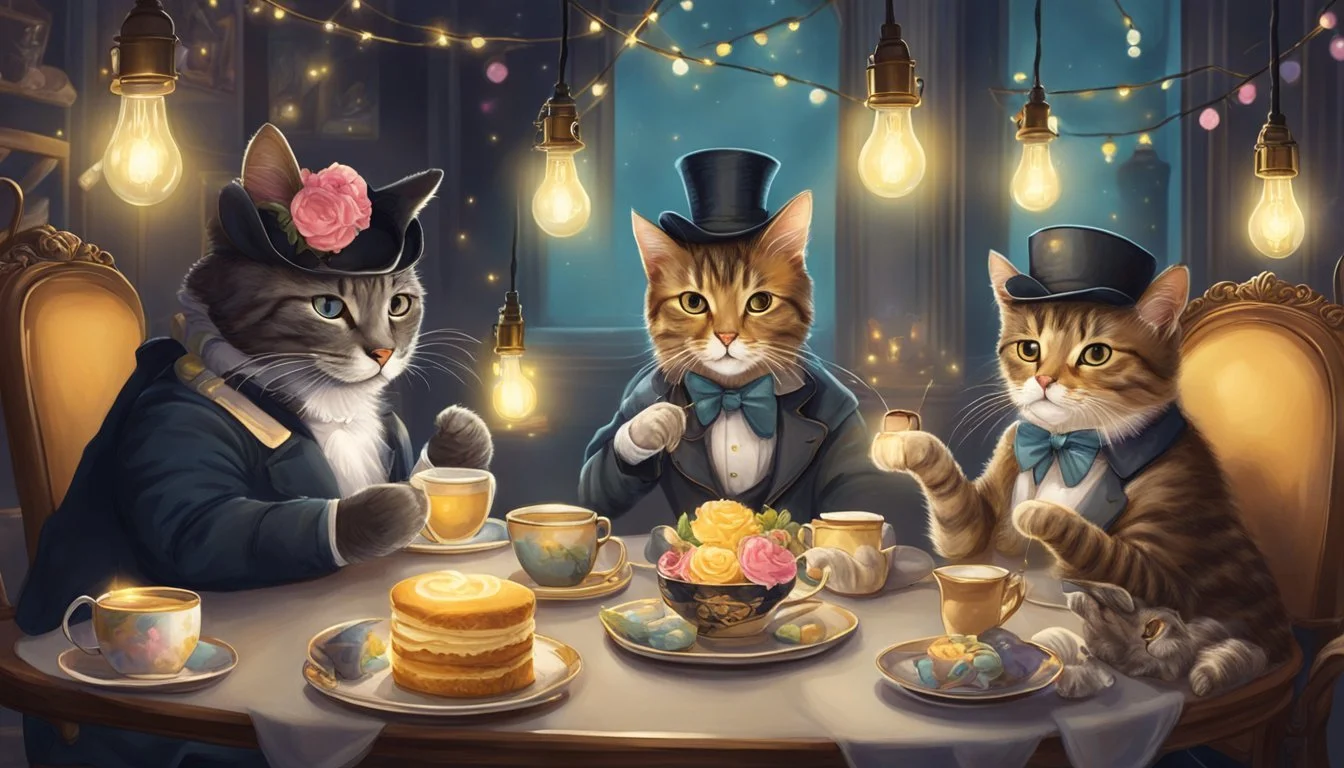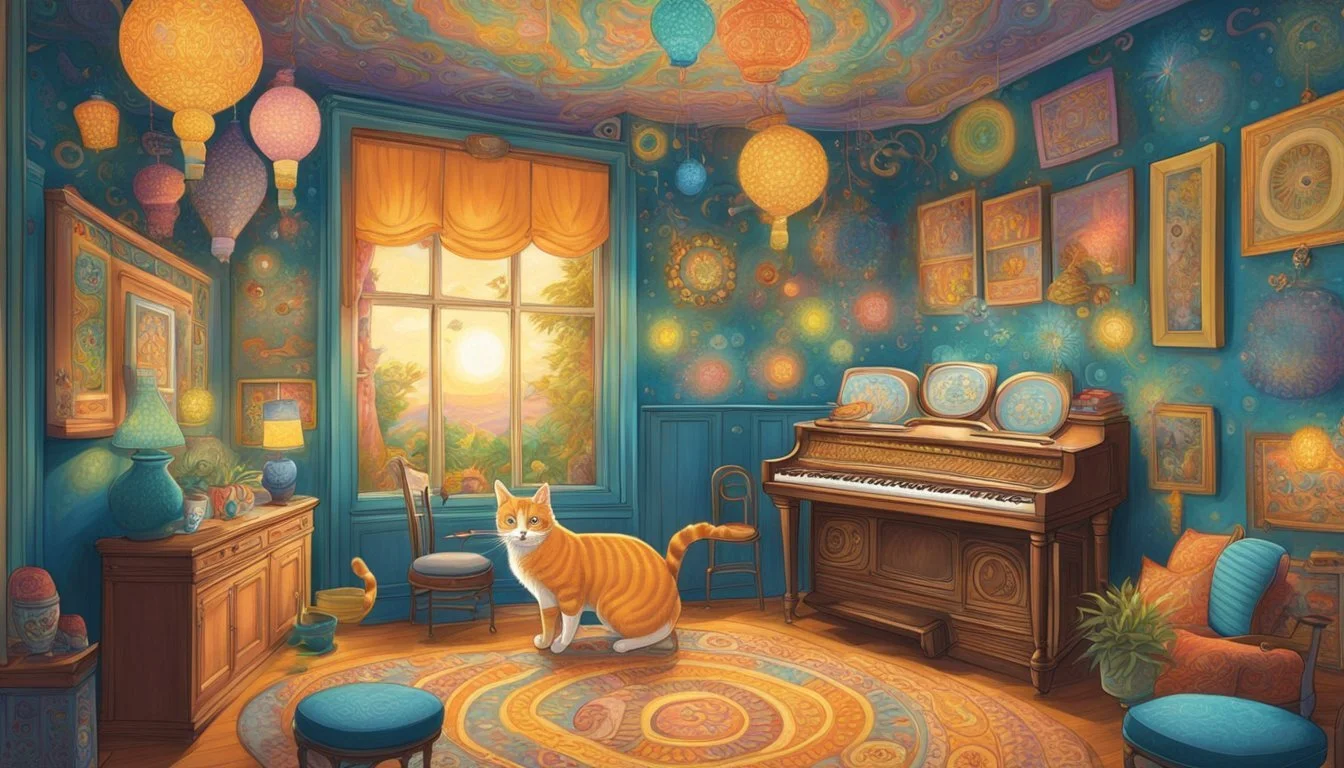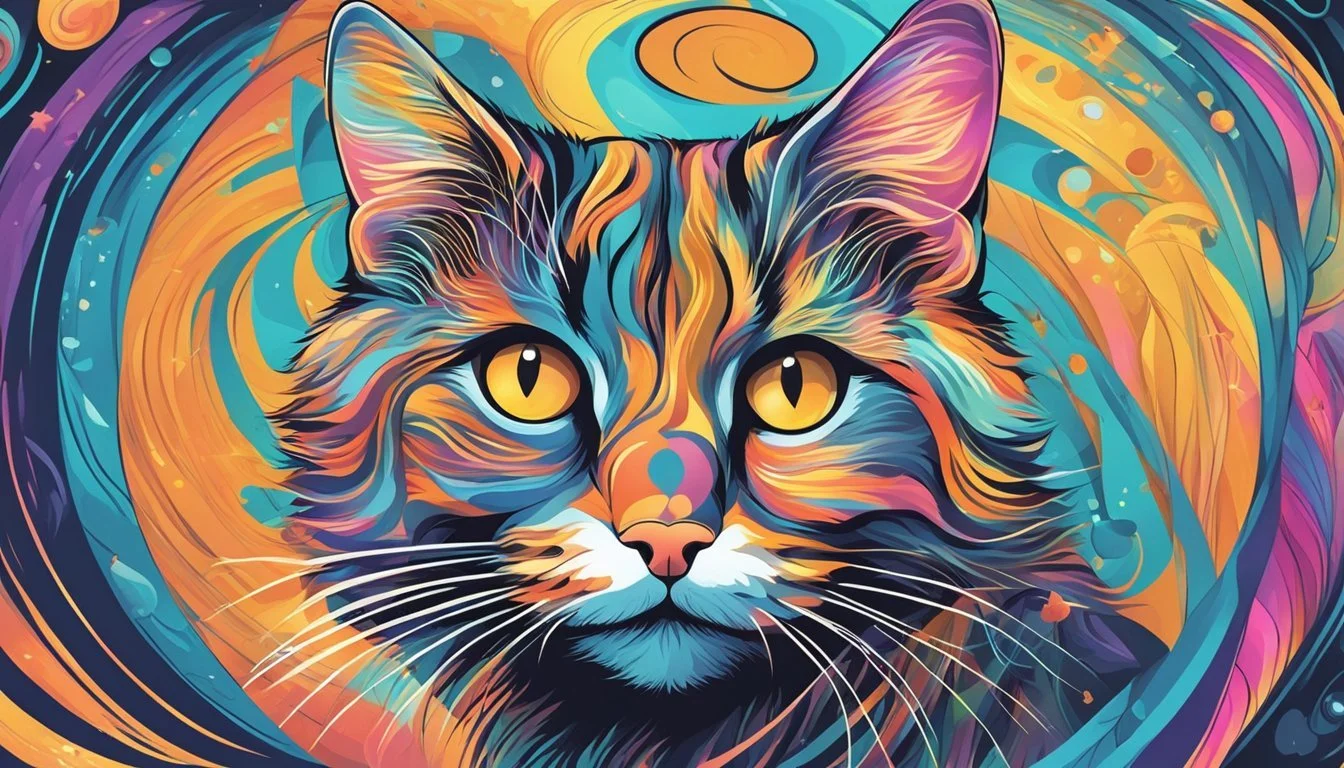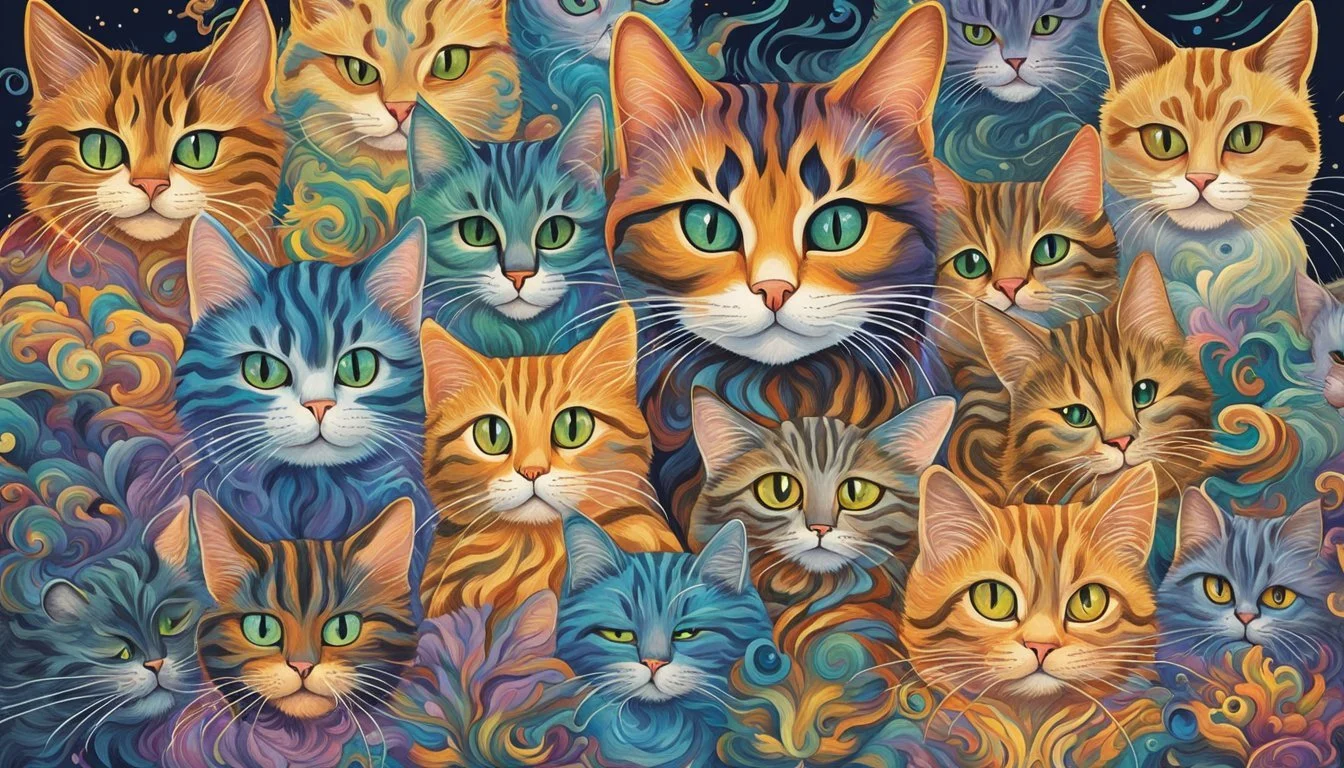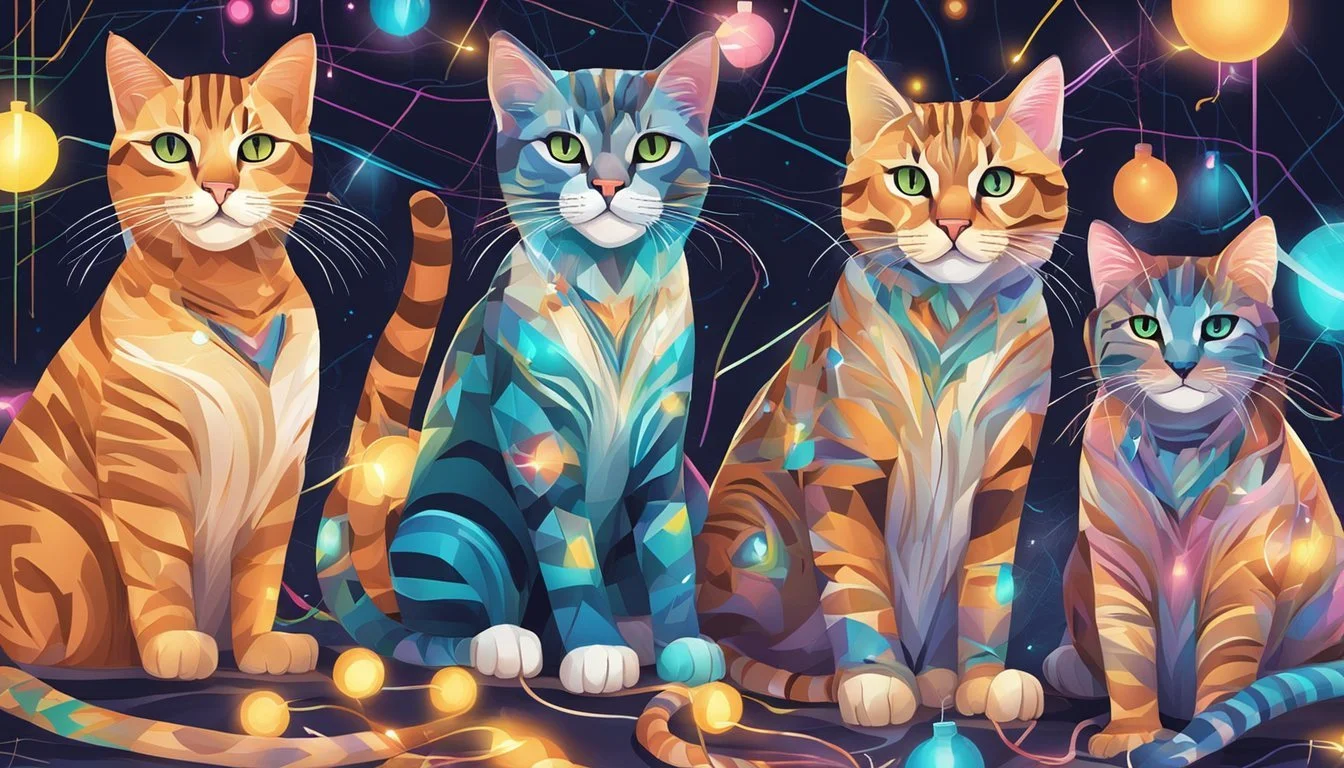Feline Fascination: The Real 'Electrical Life of Louis Wain'
A Journey Through Art and Mental Health
Louis Wain, a British artist from the Victorian era, captivated the world with his whimsical and anthropomorphic cat paintings. His life and art are vividly portrayed in the film "The Electrical Life of Louis Wain," starring Benedict Cumberbatch as the eccentric artist. Wain's colorful and often electric-themed feline artworks not only popularized cats as household pets but also reflected his unique perception of the world.
The movie delves into Wain's extraordinary talent, showcasing his ability to sketch simultaneously with both hands and produce artwork at an impressive rate. This remarkable skill contributed to his rise as a household name in late 19th and early 20th century Britain. Wain's cats, often depicted in human-like situations, struck a chord with the Victorian public and helped elevate the status of felines from mere mousers to beloved companions.
"The Electrical Life of Louis Wain" explores the artist's personal struggles and triumphs, offering viewers a glimpse into the mind of a man whose passion for cats and art intertwined in fascinating ways. The film presents a powerful portrayal of Wain's life, highlighting his contributions to both the art world and the changing perception of cats in society.
Louis Wain: Artistic Beginnings
Louis Wain emerged as a prominent figure in Victorian England's art scene, known for his whimsical cat illustrations. His artistic journey began in his youth and blossomed through early professional experiences.
Early Life and Education
Louis Wain was born in 1860 in Clerkenwell, London. He showed an early aptitude for drawing, often sketching the family's cats. At 20, Wain entered the West London School of Art. His education there laid the foundation for his future career.
Wain's artistic talents were apparent from a young age. He was known to be left-handed but could draw with both hands simultaneously. This unique ability would later contribute to his prolific output as an illustrator.
First Steps in Illustration
Wain's professional career began as a teacher at the School of Art where he had studied. He soon transitioned to freelance work, drawing animals and country scenes for various London publications.
His breakthrough came in 1884 when he joined the staff of the Illustrated London News. This position allowed Wain to refine his skills and gain exposure. It was during this period that he began to focus more on cat illustrations, which would become his signature subject.
Wain's early works featured realistic depictions of cats. These drawings caught the public's attention and set the stage for his later, more fantastical cat portraits. His unique style helped elevate the status of cats in Victorian society, transforming them from mere mousers to beloved pets.
Rise to Prominence
Louis Wain's ascent to fame in Victorian England centered on his unique portrayals of cats. His art captured the public's imagination and transformed felines into stylish, anthropomorphized figures.
Victorian Cat Society Portrayals
Wain's cat illustrations stood out for their human-like qualities and whimsical charm. He depicted cats engaged in activities like playing sports, attending tea parties, and even smoking pipes. These anthropomorphic portrayals resonated with Victorian society's growing fascination with pets.
Wain's style evolved to include more elaborate and colorful designs. His cats often wore fashionable clothing and accessories, reflecting the trends of the era. This blend of feline subjects and human characteristics created a new genre of art that appealed to a wide audience.
Published Works and Recognition
Wain's cat drawings first appeared in the Illustrated London News in 1886. This exposure led to numerous commissions and regular features in popular magazines. His work graced Christmas cards, postcards, and children's books, reaching homes across Britain.
Notable publications included "A Kitten's Christmas Party" and "Cats Away!". These books showcased Wain's talent for storytelling through illustrations. His unique style earned him praise from art critics and fellow artists alike.
Wain's popularity grew, and he became president of the National Cat Club in 1898. This position further solidified his status as Britain's leading cat artist. His influence extended beyond art, shaping public perception of cats as lovable companions.
Personal Struggles and Triumphs
Louis Wain faced significant personal challenges that shaped his life and art. His experiences with love and loss profoundly impacted his emotional state and creative output.
Emily Richardson and Love
Louis Wain's life changed dramatically when he met Emily Richardson, his sisters' governess. Despite being ten years his senior, Emily captured Louis's heart. They married in 1884, defying social norms of the time. Their union brought Wain happiness and creative inspiration.
Emily's influence on Wain's art was profound. She encouraged him to pursue his passion for drawing, particularly cats. Their pet cat Peter became a source of comfort and artistic muse for the couple.
Tragically, their happiness was short-lived. Emily's health began to decline shortly after their marriage.
The Battle with Breast Cancer
Emily's diagnosis with breast cancer devastated the couple. Wain devoted himself to her care, spending long hours by her bedside. During this difficult time, he found solace in drawing their cat Peter to entertain Emily.
Emily's illness progressed rapidly. She passed away just three years into their marriage, leaving Wain heartbroken. The loss deeply affected his mental state and artistic focus.
In the wake of Emily's death, Wain threw himself into his work. He began producing the whimsical cat illustrations that would make him famous. These anthropomorphized felines often reflected his own emotional state.
Cats in Therapy and Animal Welfare
Louis Wain's artistic contributions extended beyond canvas, influencing early developments in animal-assisted therapy and welfare. His work raised awareness about the therapeutic potential of feline companionship and the importance of animal care.
Advocating for Animal Therapy
Wain's colorful cat portraits helped shift public perception of felines from mere mousers to beloved companions. This change in attitude laid groundwork for recognizing animals' emotional benefits to humans.
Wain's art showcased cats' personalities and intelligence, encouraging people to form deeper bonds with pets. His images of anthropomorphized cats engaged in human activities made felines more relatable.
The artist's work coincided with early explorations of animal-assisted therapy in mental health settings. Though not directly involved, Wain's popularization of cats as empathetic creatures supported these emerging practices.
Supporting Bethlem Royal Hospital
Wain spent his final years as a patient at Bethlem Royal Hospital, where his artistic legacy continues to impact animal therapy programs. The hospital now houses a collection of his works in its museum.
"Animal Therapy: The Cats of Louis Wain" exhibition at Bethlem Museum of the Mind showcases the artist's contributions. This display highlights the historical connection between Wain's art and modern animal-assisted interventions.
Bethlem Royal Hospital incorporates animal therapy in its treatment programs today. Cats and other animals provide comfort and companionship to patients, building on the foundation Wain helped establish through his art.
The Electrical Life of Louis Wain on Screen
The 2021 film "The Electrical Life of Louis Wain" brings the eccentric artist's story to life on the big screen. It showcases Wain's artistic journey and his profound impact on cat culture through stunning visuals and compelling performances.
Production and Development
"The Electrical Life of Louis Wain" was directed by Will Sharpe, who co-wrote the screenplay with Simon Stephenson. The film was produced by Studiocanal and released in cinemas on New Year's Day.
Sharpe's vision aimed to capture the essence of Wain's extraordinary life and his unique perspective on the world. The production team faced the challenge of recreating Victorian-era England while also portraying Wain's increasingly psychedelic artistic style.
The film's development focused on balancing historical accuracy with creative storytelling to bring Wain's fascinating biography to a wider audience.
Benedict Cumberbatch as Louis Wain
Benedict Cumberbatch took on the role of Louis Wain, delivering a nuanced portrayal of the complex artist. His performance captures Wain's eccentric nature, artistic passion, and struggles with mental health.
Cumberbatch's interpretation brings depth to Wain's character, showcasing his evolution from a talented illustrator to a renowned cat artist. The actor's ability to convey Wain's inner turmoil and creative genius adds emotional resonance to the film.
Claire Foy stars opposite Cumberbatch as Emily Richardson-Wain, Louis's wife and muse. Their on-screen chemistry helps depict the pivotal relationship that influenced Wain's art and life.
Cinematic Representations of Psychedelic Cats
The film's visual style evolves to reflect Wain's artistic progression, particularly his later psychedelic cat paintings. Director Will Sharpe employs vibrant color palettes and surreal imagery to bring Wain's fantastical feline creations to life on screen.
These cinematic representations showcase the artist's unique vision and his perception of cats as electrified beings. The film's visual effects team worked to translate Wain's two-dimensional artwork into dynamic, moving images.
Nick Cave's involvement in the soundtrack adds another layer to the film's portrayal of Wain's increasingly abstract and colorful world. The music complements the visual journey, enhancing the audience's immersion in Wain's artistic realm.
Cultural Impact and Legacy
Louis Wain transformed the public perception of cats through his whimsical artwork. His distinctive style shaped feline imagery in popular culture and left an enduring mark on how cats are portrayed in art and media.
Influence on Modern Cat Imagery
Wain's anthropomorphic cat paintings revolutionized feline representation in art. His cats engaged in human activities, wore clothes, and displayed complex emotions. This humanization of cats helped elevate their status from mere mousers to beloved companions. Wain's "Cat World" concept, featuring cats in various social situations, became immensely popular. His style influenced countless artists and illustrators, contributing to the modern obsession with cat imagery in advertising, greeting cards, and social media.
Wain's legacy can be seen in the proliferation of cat memes and the internet's fascination with feline content. His work laid the foundation for the cat-centric visual culture we experience today.
Remembered at Bethlem Museum of the Mind
The Bethlem Museum of the Mind in London houses a significant collection of Louis Wain's artwork. This institution, located on the grounds of Bethlem Royal Hospital where Wain was once a patient, preserves his legacy. The museum displays a range of Wain's cat paintings, showcasing the evolution of his distinctive "Cat Style" over time.
Visitors can observe how Wain's art progressed from realistic portrayals to increasingly abstract and colorful depictions. The museum's collection highlights Wain's artistic journey and his impact on cat imagery. It serves as a testament to his enduring influence on popular culture and art history.
Behind the Scenes
The making of "The Electrical Life of Louis Wain" involved a talented creative team, insightful cast members, and meticulous distribution planning. These elements combined to bring Louis Wain's extraordinary story to life on screen.
Creative Team and Cast Insights
Benedict Cumberbatch and Claire Foy played pivotal roles in portraying Louis Wain and Emily Richardson-Wain. The actors delved into their characters' complexities, aiming to capture the essence of these historical figures.
Director Will Sharpe brought a unique vision to the project, blending traditional filmmaking techniques with innovative visual effects. The production team utilized a mix of practical and digital effects to recreate Wain's vibrant artistic world.
Costume designer Michael O'Connor crafted period-accurate attire, enhancing the film's Victorian and Edwardian aesthetics. The art department worked tirelessly to recreate Wain's distinctive cat paintings and illustrations.
Charlotte Wilde's Perspective
Charlotte Wilde, a key member of the production team, offered valuable insights into the film's development. She emphasized the importance of balancing historical accuracy with creative storytelling.
Wilde collaborated closely with researchers to ensure authentic depictions of Wain's life and work. She played a crucial role in selecting which aspects of Wain's extensive career to highlight in the film.
Her contributions helped shape the narrative, focusing on Wain's artistic evolution and personal struggles. Wilde's expertise aided in creating a nuanced portrayal of the artist's relationship with his cats and his mental health challenges.
Distribution by StudioCanal
StudioCanal took charge of distributing "The Electrical Life of Louis Wain" in key markets. The company developed a targeted marketing strategy to reach art enthusiasts and period drama fans.
They organized special screenings and Q&A sessions with cast and crew members to generate buzz. StudioCanal also partnered with cat welfare organizations to promote the film and raise awareness about feline care.
The distribution team carefully timed the film's release to maximize its potential during awards season. They secured deals with streaming platforms to ensure wide accessibility after the theatrical run.

